Velas 60 (invasive lipolysis)
Invasive laser lipolysis is also called small volume liposuction.
Laser lipolysis is a method of silhouette shaping, which at one time allows for local body slimming and performance of skin thermolift. It employs the effect of laser activity, which allows for precise shaping of face and body contours. While reducing the excessive adipose tissue, there is no effect of skin flabbiness, as the laser promotes skin contraction and lifting in the treated areas.
Laser lipolysis technology consists of selective action of laser beam on adipose tissue, thermally damaging fat cells. Wavelength 940nm, emitted by laser Velas 60 is close to absorption peak of fat and guarantees effective, nearly painless liposuction of local obesity and body shaping.
Due to very thick optical fibres (400-600 mimicrometres), inserted with blunt-tipped cannula of 1mm diameter and 10-20 mm length, the laser allows for the performance of a minimally invasive treatment, with local anaesthesia. Additional advantage of lipolysis with laser Velas 60 is improvement of skin elasticity by warming the collagen fibres, far less destruction than in traditional methods and minor or none discomfort after the procedure.
Advantages of laser lipolysis with diode laser Velas 60
- minimally invasive treatment
- local anesthesia
- coagulation of blood and lymphatic vessels (less bleeding)
- shorter recovery time
- possibility of performing the procedure in body areas such as: face, upper part of abdomen, knees
- improvement in superficial homogeneity of the treated skin
- chin
- facial
- neck
- arms
- breast in men (pseudogynecomastia)
- abdomen
- buttocks
- hips and thighs
Indications for laser lipolysis is reduction of fatty tissue in the following body areas:
Laser lipolysis may be performed in people with excess weight of between ten and twenty kilo at most. As it is not a slimming method, but a silhouette sculpting method, the amount of adipose tissue, which is removed, is only just the amount that is excessive in a given body area - typically, up to 2 litres.
The treatment is for everybody who wants to effectively get rid of locally accumulated fatty tissue. The method is especially dedicated to those who are a little overweight and want to remove stubborn pockets of fat from target body areas, which are difficult to reduce applying other methods.
Contraindications for laser lipolysis:
- varicose veins,
- blood coagulability disorders,
- respiratory and blood circulation diseases,
- hyperthyroidism,
- untreated diabetes.
Recommendations before the treatment:
- laboratory tests (complete blood count, liver tests, clotting),
- a week before the treatment, stop taking analgesics, aspirin and ibuprofen. In case of taking these medications for cardiological reasons, do not stop taking them, but be sure to inform your doctor before the procedure,
- do not drink alcohol for a week prior to the treatment,
- drink large amounts of water (one/two litres a day), at least for a week before the treatment and for a week after the procedure,
- in order to help to minimise bruising, you may take arnica tablets for 2-3 days before and for a week after surgery,
- a week before and after the procedure you should restrict smoking.
Laser lipolysis step by step:
Laser lipolysis treatments are performed on an outpatient basis, in a sterile treatment room. Depending on the scale of procedure, type of anaesthesia and the amount of removed adipose tissue, it may last from one to three hours. Before the procedure, the doctor marks the target areas on the patient's body with a surgical marker. The marking takes place in an upright position, so that the proper anatomical body shape and distribution of fatty tissue is clearly visible. In the treatment room, the marked patient's body parts are carefully disinfected and protected with sterile drapes. |
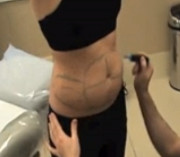 |
In order to numb the target area, tumescent solution is used, which is a local infiltration anaesthesia of dermis and epidermis by means of large amounts of highly diluted solutions of anaesthetics. "Tumescent" comes from the Latin word "tumescere", which means "swell" and defines characteristic, puffed skin and subcutaneous tissue, resulting from infusion of large amounts of fluid. |
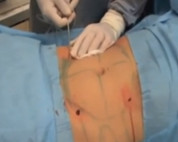 |
After administering anaesthesia, the doctor introduces a cannula (with a diameter of 1mm) with an optical fibre into the same subcutaneous incisions. The end of optical fibre breaks down the fatty cells, emulsifying them into the intercellular space. Additional advantage of adipose tissue reduction with diode laser is simultaneous closing of small blood vessels that may get destroyed during the procedure with the laser light. Their immediate closure significantly reduces bleeding and pain. Another benefit of using diode laser in lipolysis is additional possibility of simultaneous administration of subcutaneous tissue biostimulation (effect of collagen contraction) in order to obtain an effect of skin lifting after fat suction. |
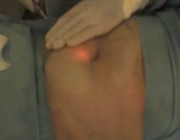 |
In case of minor treatment areas, adipose tissue, already in a liquid consistency, is sucked in small amounts. The remaining part of fat, by means of metabolic changes, is being absorbed by the body. If the treatment is applied to larger target areas, then the fatty tissue, broken down with laser, is gently aspirated (with a cannula connected to a medical sucker or a syringe). |
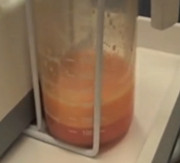 |
Effects: laser lipolysis




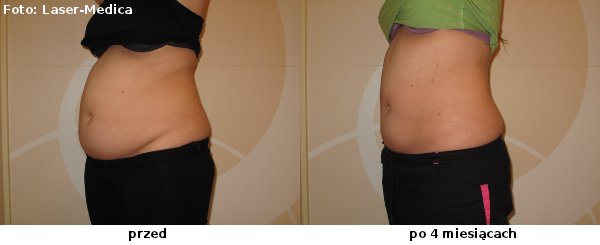


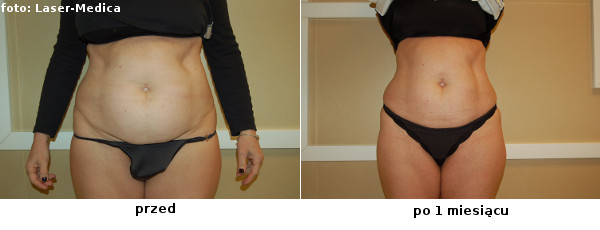
*Copying and spreading of the photos without the consent of the owner is prohibited!
See also: Skin firming - radio frequency
Unavoidable after-effects:
- bruising - usually subsides after about 2-3 weeks,
- pain - may last up to a few days or longer, it is recommended to use pain-killers (paracetamol, ibuprofen, etc.),
- swelling - may last for a few weeks;
Possible complications:
- problems with healing of the skin incisions,
- irregular body contours (swellings, skin defects, nodes) - the changes usually regress within 10 weeks, they are rarely permanent,
- burns,
- blood clots,
- accumulation of serous fluid,
- paresthesia - loss of feeling or increased sensitivity to pain, lasting for several weeks,
- in case of major skin flaccidity, after the procedure, the expected effect of skin tightening may be not achieved.
Contact your doctor promptly if you notice any signs of complications after the treatment!
 Recommendations after the procedure:
Recommendations after the procedure:
- if any medications have been prescribed, it is recommended to take them, accordingly with the doctor's orders,
- in case of any discomfort, you may use cold compresses or take paracetamol,
- there may be fluid oozing out of the incisions - it is normal and may last for a few days; it is recommended to change dressings when they get soaked,
- it is advised to wear a compression garment, according to your doctor's recommendation; it can be removed for a bath time; after 24 hours you may take it off for 1-2 hours per day, e.g. in order to wash it; the period of wearing the compression garment is about 2-3 weeks (including nights).
- it is suggested to avoid intensive physical activities for at least two weeks after the treatment or for a given period of time, according to your doctor's instruction; while total lack of activity is not recommended, as it may cause blood clotting,
- it is advised to avoid sauna and very hot baths for 7 days,
- shower/bath is recommended for the day following the procedure; after shower/bath it is advised to apply the compression garment again,
- following the laser lipolysis procedure, after a period of two weeks, it is recommended to have massage combined with lymphatic drainage in a series of 8-10 sessions (e.g. i-lipo ultra session); the first results can be seen immediately after the treatment, and the full results become visible within 2-6 months; it is also a permanent effect - the fatty tissue is no longer accumulated in an area that has been treated with a laser.
Comparison of laser lipolysis with classic liposuction
Laser lipolysis* |
Liposuction |
|
Mechanism |
Laser light permanently destroys fat cells |
Mechanical, durable sucking off fat cells |
Bleeding during the procedure |
Minor - laser coagulates blood vessels |
Increased bleeding - blood vessels are mechanically damaged |
Effects on skin tightness |
Improved tightness - laser heat contracts the collagen fibres |
After the procedure, flaccidity of skin - dermatoplasty required |
Anaesthesia method |
Tumescent anaesthesia |
Depending on the size of the area to be treated: local anesthesia, general anesthesia |
Amount of aspirated fat |
Less (up to 2 litres) |
More (3-5 litres) |
Duration of a single session |
1-3 hours |
1-3 hours |
Hospotalisation |
None |
1-2 days |
Complications |
Less |
More often, more serious (e.g. embolism) |
Recovery period |
Shorter - return to work on the day following the procedure |
Longer |
Number of required sessions |
Usually 1 |
Usually 1 |
* procedure administered in Laser-Medica Centre

